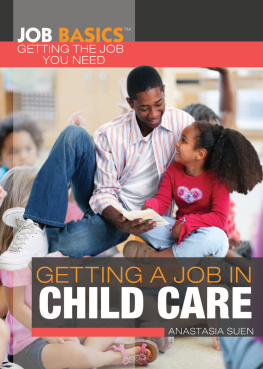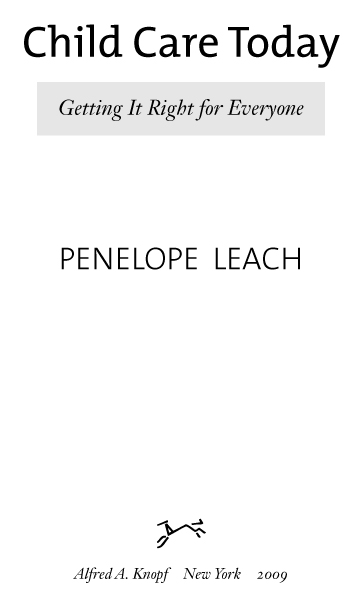Introduction
This book is about child care. In the book and in most of the research it reports, child care means just that: the care of children. It includes what used to be referred to as day care but is by no means confined to it. The distinction is important. To many people, perhaps especially North Americans, day care refers only to child care provided by people other than parents for children below school age while their mothers are out at work and mainly to care that takes place in group settings such as nurseries or centers. The real world of child care is a lot more diverse and complicated than that. For a start, even when a child is in child care for many hours and her mother, as well as her father, works a fifty-hour week, she will still spend more time with her parents and be far more intensely and lastingly influenced by them than by her other caregivers. Then, for many families child care is not a clear-cut either-or between home or child care setting but a jigsaw puzzle of people and places, family and nonfamily, paid and unpaid, in the childs home, in someone elses home, or in a professional setting. To complicate matters further, not all nonmaternal care is nonparental; there are increasing numbers of fathers caring for their children. And not all nonmaternal care is chosen to enable mothers to work or study, either. Some women are based at home and available to their children but want some separate time for their own benefit or for the childs. Some fathers and mothers want to share childrens care or to have one or the other of them solely responsible for it, and some grandparents want to spend time with children thats as much sociable as useful. We need to be aware of all that complexity, because if child care research is to inform public or personal policies usefully, it needs to be about identifying ways of caring for childrenthat fulfill the needs and fit the changed and changing lifestyles of both children and adults.
Child care is a very large and wide-ranging topic, so this book covers a lot of ground and is crammed with facts and figures, not all of which will seem relevant to every reader. American parents thinking about nonparental care for their own child may not care what is provided in Europe or Australia or how researchers judge the quality of a childrens center; they may want to start with Chapter 4, read about different types of child care in Chapters 5-12, and then go to Chapters 14-16 on judging and choosing child care, and Chapter 20 for some suggestions on making it work for whole families. However, those same parents, thinking about child care as taxpayers and voters, may welcome the discussion of political and policy issues in Part One, of the research that tells us what we know and what we still need to know about child care in Chapter 13, and of how American child care and its funding compares with that of other countries in Chapters 17-19.
Child care is not only a big topic but also one that is dangerously hot to handle. Tapping into parents desperate desire to do the best for their children and the hair trigger of their guilt when that is in question, child care stories are widely reported in all the media, whether they are individual scare stories, dry reports from the Office for Standards in Education, Childrens Services and Skills (OFSTED) in the United Kingdom, sober findings from the National Institute of Child Health and Human Development (NICHD) Early Child Care Research Network studies in the United States, or accounts of their own experiences from parents who took part in the Families, Children and Child Care (FCCC) study in the United Kingdom. And, judging by TV shows, Web sites, radio phone-ins, and letters to editors, such stories all get a huge response from their audiences. Unfortunately, that wide interest and coverage says more about increasingly intense concern about child care than about widespread or growing understanding of it. There is more written but less understood about child care than about almost any other single topic that is relevant to almost everyone. And the more sensitive the topic becomes, the more difficult it is to present objective facts or measured accounts, to identify gaps in our knowledge, and to open honest debate, as this book hopes to do.
The topic of child care is becoming more sensitive because, after two generations of startlingly rapid social change and almost a decade into the new millennium, we are still looking at it backward, treating the sole mother care that was typical of white middle-class families for a generation after the Second World War as a gold standard against which to measure (and decry) todays child care and sometimes look askance at todays parents. It is difficult to imagine a less useful mind-set. Rapid social change is the context for many parents problems and the starting point for this book, but it is neither a diagnosis nor a cure. Understanding more about how things have changed will not, in itself, make it much easier to cope with the way things are. And looking at the differences between today and yesterday, between our children and our childhoods, will neither resolve regrets nor produce solutions. History never runs backward. We dont get a second shot but have to try to figure out how to live with and enjoy what weve got in the time and place that were in, and perhaps exert some control over where were going.
Whatever the brief period between the end of the Second World War and the 1970s when sole full-time mother care was the social expectation or aspiration meant to children, it meant isolation and discrimination to many of their mothers and hastened its own ending by helping to power them into the womens movement. Modern sociology recognizes that in each society some women want to give priority to children and home rather than to paid work, but wide acceptance of that particular form of nuclear-family living and gendered division of labor is over. We know that modern economies absolutely require womens work as well as mens, that of parents as well as those without children, yet we are still arguing about whether it is bad for children to have working mothers. Looking regretfully over our shoulders at a rose-tinted past stops us from making realistic assessments of the present or looking forward to how we could make a better future, and both are urgent. The reality is that nonmaternal child care is a fundamental part of modern societies; until we acknowledge that, we shall not recognize, let alone address, the unpalatable reality that much child care, especially forchildren under three, is currently of dismally low quality. We know this; anyone who reads research studies or reports of them from North America, Australia, or the United Kingdom knows it including millions of anxious parents who would rather not. Less known, though, and far more shameful is that we know how to improve the quality of child care, and we are not doing it.
If we stopped pretending that parents are solely responsible for child care; stopped implying that if nonparental care isnt good, the only alternative open to good parents (mostly mothers) is to care for children themselves full-time, whether or not that is what they want to do, we could stop looking back and use what we know to move forward. Some countries have already moved farther forward than others. Countries need to learn from one another. The United States is unique among Western countries in having no federally mandated paid maternity or parental leave, and its programs to assist poor parents with child care fees are underfunded. In contrast, parental leave in Finland is so generous and well paid that having a parent at home with a baby or toddler is a realistic alternative to child care, which is freely available to all parents who choose it and, like later schooling, financed out of general taxation. Between these extremes, child care in the United Kingdom must still be paid for by the parents who use it, but paid maternity leave can now last nine months for any employed mother, and every three- and four-year-old is entitled to free half-time preschool education. We need answers to positive questions: What are the real issues in combining the human essentials of earning and caregiving? What types of child care are there? What is high-quality child care likefor which children in which families and when? How can it be provided and paid for?







